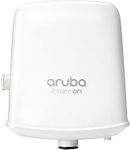Buying Guide for the Best Outdoor Access Points
Choosing the right outdoor access point is important for ensuring reliable and strong wireless coverage in open or semi-open environments. Outdoor access points are designed to withstand weather conditions and provide Wi-Fi connectivity over larger areas, such as gardens, campuses, or public spaces. When selecting one, it's important to consider where and how you'll use it, the number of users, and the type of devices that will connect. Understanding the key specifications will help you match the access point to your needs and ensure a stable, secure, and efficient wireless network outdoors.Weatherproof Rating (IP Rating)The weatherproof or IP (Ingress Protection) rating tells you how well the access point can resist dust and water. This is crucial for outdoor use, as the device will be exposed to rain, dust, and possibly extreme temperatures. IP ratings are usually shown as two numbers, like IP65 or IP67. The first number refers to protection against solids (like dust), and the second to liquids (like water). For most outdoor environments, an IP65 or higher is recommended. If your area experiences heavy rain or dust storms, look for higher numbers. If the access point will be under a roof or in a sheltered spot, a lower rating may be sufficient.
Wireless Standard (Wi-Fi Version)The wireless standard, such as Wi-Fi 5 (802.11ac) or Wi-Fi 6 (802.11ax), determines the speed, efficiency, and capacity of the access point. Newer standards offer faster speeds and better performance with many devices connected at once. Wi-Fi 6 is ideal for busy areas or future-proofing, while Wi-Fi 5 is often enough for smaller spaces or fewer users. Choose the standard based on how many people and devices will connect and whether you want the latest features.
Coverage RangeCoverage range indicates how far the access point can broadcast its signal. This is usually measured in meters or feet. A larger range is important for big outdoor areas, but keep in mind that obstacles like trees or buildings can reduce the effective range. If you need to cover a large open field, look for a higher range. For smaller patios or courtyards, a shorter range may be enough. Always consider the layout of your space and any potential obstructions.
Antenna Type and GainAntenna type (internal or external) and gain (measured in dBi) affect how the signal is distributed. Higher gain antennas focus the signal in a specific direction, which is good for long, narrow areas, while lower gain antennas spread the signal more evenly in all directions, suitable for open spaces. If you need to cover a specific path or corridor, choose a higher gain directional antenna. For general coverage, an omnidirectional antenna with moderate gain is usually best.
Power Options (PoE Support)Power options refer to how the access point receives electricity. Power over Ethernet (PoE) allows the device to get power and data through a single network cable, which is very convenient for outdoor installations where power outlets may not be available. If you plan to mount the access point far from a power source, look for PoE support. If you have easy access to power, a standard power adapter may be sufficient.
Security FeaturesSecurity features protect your network from unauthorized access. Look for support for the latest encryption standards, like WPA3, and features such as guest networks or access control. If you are setting up Wi-Fi in a public or semi-public area, strong security is essential to protect your users and data. For private or home use, basic security may be enough, but it's always better to choose an access point with up-to-date security options.
User CapacityUser capacity indicates how many devices can connect to the access point at the same time without performance issues. This is important for busy areas like parks, campuses, or event spaces. If you expect many users, choose an access point with a high user capacity. For home gardens or small gatherings, a lower capacity may be sufficient. Think about both current and future needs when considering this specification.














